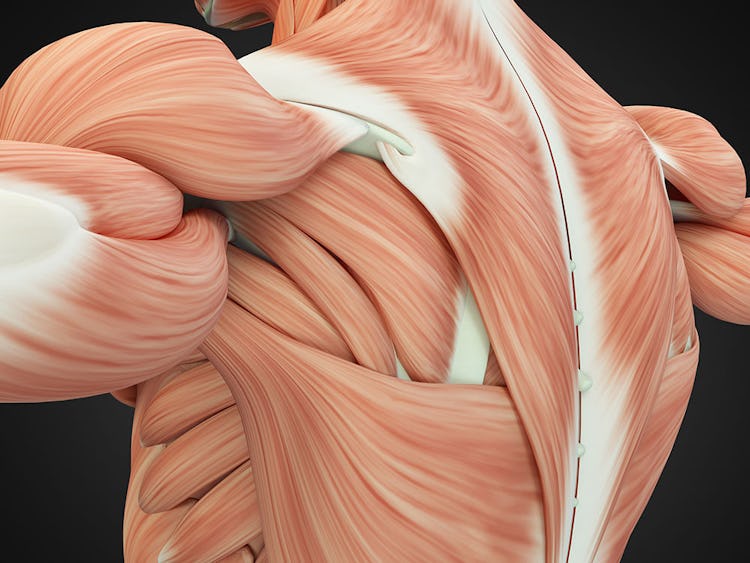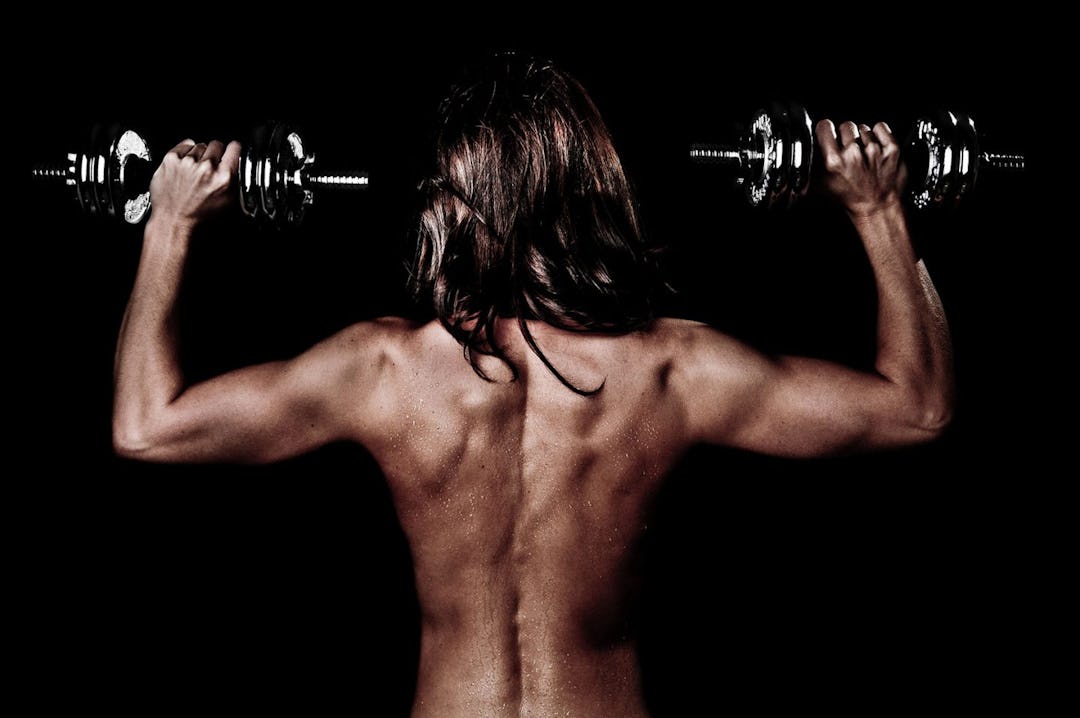If you ever watch Olympic weightlifting competition, you’ll see absurdly strong men and women trying to lift the heaviest loads on two lifts: the clean and jerk and the snatch. But before the 1972 Olympics, there was a third lift that was contested—the clean and press. To perform it, the lifter must pull the barbell off the floor and heave it up to shoulder level (the clean), and from there, strictly press it overhead to lockout.
The clean and press was dropped from weightlifting competition because judges deemed it too difficult to assess valid technique (lifting a ton of weight causes you to bend backward, and it’s hard to tell to what degree the knees are bending, and therefore how much assistance you’re getting from them). Though it may have fallen out of fashion, the clean and press is still a worthwhile exercise, and an efficient choice for building muscle, strength, and explosiveness—even if you choose to perform it with dumbbells. In fact, the dumbbell clean and press is arguably a better choice for most people than its barbell predecessor (particularly those of us who aren’t trained Olympic lifters).
The dumbbell clean and press will allow you to access most of the same benefits gleaned from the barbell variation, but without the same steep learning curve or risk of injury. Here’s everything you need to know about the dumbbell clean and press.
What Muscles Does a Dumbbell Clean and Press Work?

The dumbbell clean and press works just about all of the major muscles along the posterior and anterior chains (i.e., the muscles that work together on the back and front of the body). In other words, it’s a total-body exercise.
Starting at the bottom of the body, the gastrocnemius and soleus muscles in the calves work in tandem with the quads, hamstrings, and glutes to drive the weights up from the floor (or hang position; see below) and extend the hips. The abdominals (including the rectus abdominis, transversus abdominis, and internal and external obliques) and spinal erectors provide stability for the spine as you extend the hips and stand up tall.
The traps, lats, and rhomboids contract powerfully to shrug and pull the weights up to shoulder level. As your elbows come under the dumbbells, the muscles of the hands and forearms work hard to maintain grip, while the biceps come under tension, too. To finish the exercise with a press, the deltoids, upper pecs, and triceps fire as the core works to maintain stability.
What are the Benefits of Doing the Dumbbell Clean and Press?
“The dumbbell clean and press develops total body-strength and power, and stability in the shoulders,” says Sean Pangelinan, owner of The Fit Lab in San Diego. Like the barbell clean and press, the dumbbell version has you taking a weight from the floor (or at least knee level) and controlling its path all the way overhead. You can’t ask for a greater range of motion through which to work your whole body, and the result is a total-body workout. Working all those muscles burns a lot of calories for one exercise, so the clean and press is a good move to use when training for fat loss. Though you won’t be able to lift as much weight with dumbbells as you do a barbell, the exercise is still intended to be done heavy, so you’ll build strength and size.
While you sacrifice some loading using dumbbells, they offer a few big advantages over a barbell. For one thing, they make the exercise unilateral. You have to control two weights separately, but coordinate their movement together. That increases the challenge to your core and many stabilizer muscles, including the ones in the shoulders that you need to press safely in any exercise. The dumbbells also offer a slightly greater range of motion than you’d get with a barbell clean and press, and greater range means more muscle activation.
“The dumbbell clean and press is a great introduction to the Olympic lifts,” says Pangelinan, “and is more forgiving for most people who don’t have experience in this area. You get most of the benefits of cleaning and pressing with a barbell, minus the stress on the wrists and other joints. The clean and press is one of the most efficient movements you can do, as it’s a compound lift that engages multiple joints and major muscle groups.”
How To Stretch Before A Dumbbell Clean and Press
Use these two mobility drills, provided by Onnit Durability Coach Natalie Higby (@nat.trill.fit on Instagram), to increase range of motion and stability in your shoulders and upper back before you perform the clean and press.
How To Do A Dumbbell Clean
It’s easier to learn the dumbbell clean and press when you break it down and master its component parts individually. This means starting with the dumbbell clean. A proper clean is not a sloppy curl done with momentum. When done correctly, it’s a full-body movement that builds power. Here’s how to do the clean portion of the clean and press.
Step 1. Place two dumbbells on the floor. You may position them so that the handles are horizontal, right in front of your feet. However, if it feels like they’re too far away to reach, you can place them vertically at the outsides of your feet—or angled slightly inward. If the floor still seems too far away, and you know you won’t be able to pick up the dumbbells without rounding your lower back (don’t worry, this is common), simply start with the dumbbells hanging at your sides.
Step 2. Stand with your feet straight and hip-width apart. Hinge at your hips, bending them back and allowing your knees to bend until you can reach the dumbbells on the floor. You should end up in the same starting position as a deadlift. Grip the dumbbells with your arms straight. Your head, spine, and pelvis should all be aligned.
If you’re starting from a standing position, bend your hips back and allow your knees to bend as needed until the dumbbells hang just outsides your knees. This is called the hang position of a clean, and you can begin the exercise from here.
In either case, draw your shoulders back and downward (think “proud chest”), so that someone standing in front of you could read the front of your T-shirt.
Step 3. Push your feet hard into the floor and squeeze your abs and glutes. Extend your hips and knees to get the dumbbells moving upward.
Step 4. As the weights pass knee level, shrug your shoulders hard, squeeze your glutes again, and allow the momentum to carry the dumbbells up in front of you.
Step 5. Thrust your elbows forward so that they come under the dumbbells and you “catch” the weights at shoulder level, bending your knees to drop into a quarter squat to absorb the force. Your thumbs should be facing backward and your closed palms facing each other.
How To Do A Dumbbell Clean and Press
To perform the full clean and press, clean the weights up to shoulder level as described above. From there:
Step 1. Ensure that your tailbone is tucked under slightly so that your pelvis is parallel to the floor. Brace your core, pulling your ribs down.
Step 2. Press the weights straight overhead to lockout while keeping your ribs down. Reverse the motion to bring the weights back to shoulder level, and then bend your hips back to lower them to the floor (or your knees) again.
How Many Reps Should I Do?
If your goal is power and strength, Pangelinan suggests doing the clean and press for sets of 3 to 6 reps. Three work sets (the challenging ones you do after your warmup sets) is enough. “This is the ideal amount of volume to get the full neuromuscular benefits of the exercise,” says Pangelinan, “without your form being compromised by fatigue.”
However, if you’re aiming to build your endurance and get more volume for the sake of muscle size gains, you could do 3 sets of 10 to 20 reps with a lighter weight. “Just make sure you stop if you begin to slow down or your technique deteriorates,” says Pangelinan. If you’re brand new to clean and presses, train with lower reps first to master the movement, and work on endurance after you’ve gotten the technique down.
Like the other Olympic lift variations, the dumbbell clean and press is a versatile movement that can be done in combination with other movements or with slight variations of technique. You can use the clean portion to get the weights into position for front squats or front-loaded lunges. Called the front rack position (weights held at shoulder level), you can also go into different pressing movements or overhead carries from there. If you want to train heavier or target even more power development, you can perform the press portion with leg drive, making it a push press exercise (shown in the video above). In other words, clean the weights up to your shoulders, and then quickly dip and extend your knees to help power the dumbbells overhead. Pressing the dumbbells strictly is better for shoulder strength and muscle gain, but getting assistance from your legs tweaks the exercise into more of a full-body power move.
At The Fit Lab, Pangelinan’s clients often combine the dumbbell clean and press into a circuit with reverse lunges and Romanian deadlifts. “I’ll also add in single-arm rows to improve scapular control, pushups as an antagonist to the vertical pull component of the clean and press, and single arm floor presses,” he says. Now you have a full-body circuit workout that’s great for fat loss.
Alternatives to the Dumbbell Clean and Press
If you’re not ready for the full dumbbell clean and press, you can regress the movement to something more manageable. If you want to make it even more challenging, there are progressions you can employ as well. See below for some alternatives you can use to customize your training.
Regression
If you’re not able to perform a dumbbell clean and press explosively, or you struggle with one or more stages of the exercise, no need to worry. Pangelinan recommends backing up and working on some foundational moves. “When someone’s struggling with the clean and press, we’ll work on the dumbbell deadlift, upright row, and press, separately, to groove the patterns of each phase of the movement,” he says. “I’ll also have them do quarter-jump squats [lowering your body just one-quarter of the way down], to work on the explosive component, and an overhead waiter carry to improve the integrity of their overhead position.” For the waiter carry, simply press dumbbells or kettlebells overhead and walk for distance or time. Keep your ribs down, core tight, and pelvis level with the floor.
Progression
Once you’ve got the two-handed dumbbell clean and press down, you could start doing single-arm clean and presses (shown in the video above), which add an even greater challenge to your stability and can help you correct any strength discrepancies between sides. “The kettlebell clean and press is another great alternative for someone who’s competent in the dumbbell variation,” says Pangelinan. Kettlebells require even more core stability and grip strength to control, so they’ll develop both areas.
Of course, you can also experiment with the barbell clean and press. “Start with a power clean from above the knees,” advises Pangelinan, “which gives you most of the advantages of the full clean, but with a shorter amount of bar movement, so it’s easier to control.” When that feels comfortable, you can start cleaning from below the knees, and eventually progress to full cleans from the floor.
If you want a more joint-friendly alternative to a classic barbell clean and press, try using a landmine unit (see above). The bar loads into a rotating sleeve that allows it to act as a long lever and move on an arc. The path of motion will be more controlled than doing a pure free-weight movement, but you’ll still have to stabilize it, and you won’t have to deadlift and catch the bar the same way as you do during a normal clean and press, which will take a lot of pressure off your lower back, wrists, and elbows. Still another option is using a Pentagon bar (see below). This barbell alternative offers swiveling handles, so you can get the feel of cleaning a barbell without the wrist and elbow stress, or having to time your clean perfectly to avoid a sloppy catch.

)





